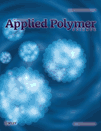Composition control through pH and ionic strength during acrylic acid/acrylamide copolymerization
Abstract
The possibility of controlling the composition of acrylic acid/acrylamide copolymers by controlling the pH and the ionic strength of the reaction medium is investigated. The reactivity ratios of charged monomers depend on the pH of the medium, acrylic acid is the more reactive monomer below pH 3 and acrylamide above pH 4. The working pH was set at 3.6, a candidate for the crossover point, where no composition drift is expected. Copolymerization kinetics is investigated at this pH at various ionic strengths and a reaction without composition drift up to 80% conversion was achieved. All the chains produced in this reaction contain 30% ± 3% acrylic acid. Copolymer conversions, molecular weights, and composition distributions were measured through Automatic Continuous Online Monitoring of Polymerization (ACOMP) system. The copolymerization data were analyzed by a recent error in variables method (EVM) and reactivity ratios are calculated. The results show that in salt free conditions, the reactivity ratios depend on the ionic monomer concentration (ionic strength) in addition to the pH of the reaction medium. The effect of polyelectrolytic interactions on the reactivity ratios and the resulting composition drift during the reaction, sequence length distribution, and Stockmayer bivariate distribution are discussed in detail. © 2012 Wiley Periodicals, Inc. J. Appl. Polym. Sci., 2013




